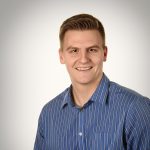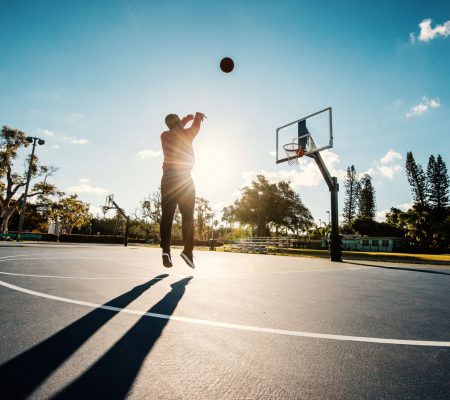In the Patient’s Shoes: My ACL Reconstruction Journey as a Physical Therapist Part 3: Returning to Sports
Erik Kust, PT, DPT, OCS
My name is Erik Kust and I am an orthopedic clinician at the Orthopaedic Hospital of Wisconsin. I am board certified in physical therapy and have my doctorate specializing in evidence-based musculoskeletal care. I have countless experiences treating patients for ACL injuries, but after sustaining my own injury, I was in the patient’s shoes. After going through the ACL reconstruction process, it was time for me to return to sports.
 I’ve outlined the details of my ACL injury and surgery, as well as my rehabilitation and recovery in previous posts. After tearing my ACL during a volleyball game, I managed some recovery with physical therapy. Unfortunately, during a soccer game a few months later, I sustained a bucket-handle meniscus tear and required meniscus and ACL reconstruction surgery. Once I completed my standard post-surgical rehabilitation, I was able to enter the end-stage of rehabilitation and begin my return to sports.
I’ve outlined the details of my ACL injury and surgery, as well as my rehabilitation and recovery in previous posts. After tearing my ACL during a volleyball game, I managed some recovery with physical therapy. Unfortunately, during a soccer game a few months later, I sustained a bucket-handle meniscus tear and required meniscus and ACL reconstruction surgery. Once I completed my standard post-surgical rehabilitation, I was able to enter the end-stage of rehabilitation and begin my return to sports.
Of course, there are many different considerations before returning to sports after ACL reconstruction, as with any major surgery. A year after my surgery, rehabilitation is an ongoing process, but I’m continuing to make progress. Here’s how my path to recovery went to wrap up this series on my ACL journey.
How I Started Returning to Sports After My ACL Injury
Before I begin discussing my return to activity after my ACL injury, I want to revisit a few of the points I brought up in my last blog post on rehabilitation and recovery.
After appraising current scientific literature, it’s my opinion that strength testing is the most critical piece of objective information to determine if a patient is ready to return to sport (RTS). However, even though strength testing is a vital part of RTS testing, it’s not the only criteria physical therapists use to guide their determination.
There are several additional tests and measures available that we label as “functional tests.” The level of functionality of these tests is a topic for a different blog, but many of the tests are well-researched enough to support their inclusion in a regimen of RTS testing. These standard measures include the single-leg hop, triple hop, crossover hop, lateral hop, 6m timed hop, T-test, pro shuttle test, and the drop jump test.
There are a plethora of different measures that physical therapists use to determine patients’ readiness to return to sports after ACL reconstruction, and those above aren’t even an exhaustive list! With so many ways to objectively evaluate the sports-readiness of ACL rehabilitation patients, the quantity of these tests is not the issue.
The main issue when it comes to RTS testing is getting PT professionals to use these objective tests. You’d be surprised how many health care professionals use the “eye-test” or set an unfounded timeframe to assess RTS. If you are in a situation where a set time frame or opinion that “you look good” is the extent of the RTS evaluation, please seek another opinion!
Passing the Return to Sport Test After ACL Reconstruction
The key with all these activity-readiness tests is to use them together to create a thorough picture of the physical state of the athlete. During rehabilitation, the athlete’s psychological state is also hugely relevant. Emerging evidence even shows changes in the brain may occur after an ACL injury.
When assessing myself for RTS, I used the lateral hop, crossover hop, and drop jump tests in conjunction with strength testing. My goal was to score at least a 90% limb symmetry index (LSI) with every measure. Once I achieved that goal, I began my RTS process.
Returning to sports after ACL reconstruction isn’t a matter of flipping a switch. In other words, you don’t go from rehabilitation one day to playing your sport the next. Meeting the goal of 90% LSI in both strength and functional testing opened the door for what is called on-field rehabilitation (OFR). OFR is an essential part of the process for returning to sports after ACL reconstruction.
On-field rehabilitation generally consists of performing complex, sport-specific movement with full confidence and competency. OFR bridges the gap from RTS and the return to complete (pre-ACL injury) performance. For athletes, it isn’t enough to be able to go through the motions of the sport; they must excel at the movement comfortably so that they can perform at the highest level.
Putting On-Field Rehabilitation into Play
While I’m not a professional athlete, I genuinely love playing sports. My sport of choice is basketball. Throughout my rehabilitation process, I spent time doing portions of basketball movements like jumping, landing and shooting to help me get ready to return to sports after fully recovering from my ACL injury.
However, in a therapeutic setting, there was nothing to react to like I would see during a real game. With no external stimulus, there wasn’t anything to challenge and force me to make an unplanned movement. I classify in-game rehabilitation as reactive on-field rehabilitation or “reactive OFR.” I needed to be ready to produce any movement required on a moment’s notice for a successful return to sports following my ACL reconstruction.
To incorporate reactive motions into my rehabilitation, I played one-on-one with a training partner who would force me to change directions when driving and to react openly to play defense. I would also pass the ball off a rebounding surface and catch, turn, jump, shoot, and land. It took creativity and exploration in my field of play to feel comfortable with my ability to tolerate any situation a competitive basketball game could throw at me.
I believe that OFR is a crucial portion of the rehab process that physical therapists and patients shouldn’t overlook. Finding a professional who understands your needs as an athlete will only aid in your ability to get back to your sport successfully following any injury.
The OHOW Difference in Post-Surgical Recovery
The Orthopaedic Hospital of Wisconsin, where I work and had my surgery, delivers on all aspects of ACL rehabilitation, including OFR. In addition to providing exceptional open communication between the physical therapists and orthopedic surgeons, we uniquely understand the needs of athletes. This is one reason why we hold multiple athletic trainer contracts with Milwaukee-area high schools and colleges.
OHOW’s connection to athletic trainers is vital for coordinating end-stage ACL rehabilitation and OFR. Athletic trainers (ATs) assist in the development and implementation of athlete-focused rehabilitation programs. An added benefit of working with ATs is that they often have access to key facilities and I always look forward to working with our local ATs on rehabilitation.
I hope sharing my personal and professional insights about ACL rehabilitation has given you a better understanding of what to expect following an ACL injury. Rehabilitation is a trying and rewarding process, and I’m glad to share my journey with you. As always, please feel free to contact me with any questions or to set up an appointment.


